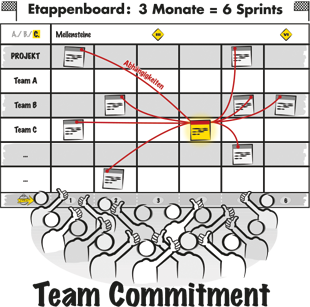
Defeat.
We are in the team cabin of a football team. It’s a big cabin, as the team size with staff is 75 people. The mood is depressed as the team has just lost the cup final. You can feel the silence all over your body!
Finally, the coach takes the floor and draws attention to the grievances of the team:
“We didn’t perform as a unit today”.
“You didn’t get the feeling that it was clear to everyone what our game plan was”
“Do we even know where we stand as a team right now?”
“We need to reflect on how we can improve working together!”
“What are the risks of our tactics and when can we take them?
Do such problems sound familiar to you? Have you experienced something similar yourself?
What were the reasons at the time that many people were working on a project but not everyone was pulling together?
I experienced a good example of this in a project with an automotive supplier.
The product development of a new cylinder head was on the agenda. It had to be a cylinder head that would do justice to the design of the sports car. The engineering department was very enthusiastic, which was directly reflected in the first concept. The engine was derived from a racing car and was equipped with all the technical bells and whistles. The cost side was not the biggest priority here. This of course pissed off the market side, because this concept would blow the budget and put massive pressure on the project side in their strict project plan. But the development of the first concept had already taken up a lot of time and budget, and the entire project was already beginning to falter.
What could have prevented this predicament?
A BIGROOMMEETING!

Why a BIGROOMMEETING?
Why a BIGROOMMEETING?
In BIGROOMMEETING there is a clear location determination and a system demo in which all participants are synchronised on the next intermediate goals via the stage planning.
Personal relationships are established and maintained, dependencies as well as priority conflicts between the teams are clarified and risks are identified and limited.
Now that it is clear to the coach what needs to be done, he starts with the first step.
Each player has to know how he has to play in the team, which running routes he can choose and how he has to act in his group, e.g. in the defence!
Why is that essential?
Only if we ourselves know what we need to be individually strong, can we make precise demands and expectations on the rest of the team. In everyday project work, this is defined by the stakeholders.
The stakeholders who are related to this project reveal their expectations and inputs and define which customer promises are pending as features in this or the next stage!
The project, architecture and business plan is updated and incorporated into the backlog.
Which parts of the EPICs should be completed in this stage? These EPICs must then be broken down into shares.
Shortly before the BRM, a system demo takes place in which the findings are incorporated into the backlog. This is followed by a first breakdown of the POT’s, which share individual teams have in the PI objectives or features. This is followed by a dry run with a few participants, as well as a technical check and briefing of all Agile coaches and POTs.

The day of the BIGROOMMEETING.
Now the long-awaited day is upon us. The coach has called everyone together for a joint meeting. The team reflects on what went well in the past and, of course, what needs to be improved. The individual groups of defence, offence and specials coordinate with each other and create an overall picture of how they want to perform as a team in terms of interpersonal skills, attitude and tactics in order to build on the successes of the past.
The decisive factor for BIGROOMMEETING is that all teams meet each other and an animated exchange takes place, in which you make your individual interests known and coordinate and possibly adjust them in the overall context with all teams.
In the project context, this means that the business context is presented by the POT, a system demo is carried out, the last stage is retrospected and the individual teams come together in break-outs to discuss and synchronise the individual stories of the stage.
They also discuss how to mitigate the risks and what risks they can live with if they occur. Finally, there is the Confidence Vote: Are we likely to be able to do this?

Let the results speak for themselves!
Now that everyone is coordinated, all the findings and decisions are implemented in a stage plan for each team. Now nothing stands in the way of holistic success and the next cup final can come.